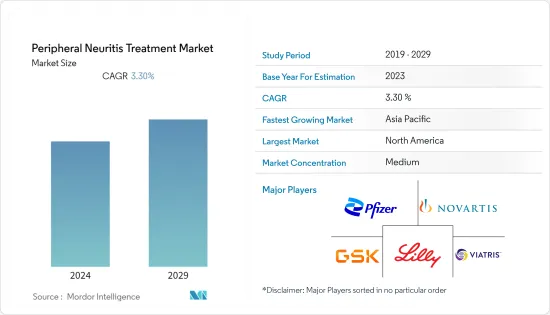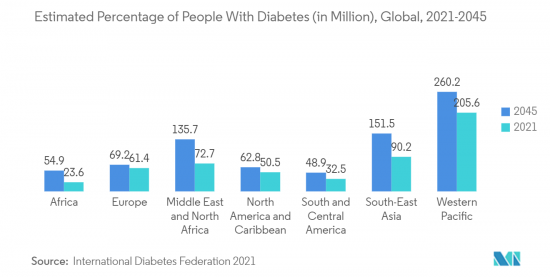
|
市場調査レポート
商品コード
1405730
末梢性神経炎治療:市場シェア分析、産業動向と統計、2024年~2029年の成長予測Peripheral Neuritis Treatment - Market Share Analysis, Industry Trends & Statistics, Growth Forecasts 2024 - 2029 |
||||||
カスタマイズ可能
適宜更新あり
|
|||||||
| 末梢性神経炎治療:市場シェア分析、産業動向と統計、2024年~2029年の成長予測 |
|
出版日: 2024年01月04日
発行: Mordor Intelligence
ページ情報: 英文 117 Pages
納期: 2~3営業日
|
- 全表示
- 概要
- 目次
末梢性神経炎治療市場は予測期間中にCAGR 3.3%を記録すると予想されています。

COVID-19患者は回復期に末梢神経炎の合併症と診断されたため、COVID-19は末梢性神経炎治療市場に大きな影響を与えました。例えば、2022年4月にMDPI誌に掲載された論文によると、コロナウイルス疾患患者のかなりの割合で様々な神経学的症状が報告されています。研究者らは、院内で集学的リハビリテーションを受けている回復期のCOVID-19患者を対象に、末梢神経系(PNS)病変の有病率と重症度を調査しました。この研究では、COVID-19の回復期における神経障害のリスクが関連することが示されました。このように、COVID-19は末梢神経炎の合併症を上昇させ、パンデミック中に治療の需要が高まった。現在、パンデミックの規制が緩和され患者が減少するにつれて、末梢性神経炎治療市場は、慢性疾患の増加と末梢性神経炎治療のための主な開発の急増により、大きな成長を示すと推定されています。
末梢神経炎に関連する疾患の負担の増加や老年人口の増加などの要因が、予測期間中に末梢性神経炎治療市場を活性化すると予想されます。
国際糖尿病連合によると、2021年には約5億3,700万人の成人(20~79歳)が糖尿病を患っています。糖尿病患者の総数は、2030年には6億4,300万人、2045年には7億8,300万人に増加すると予測されています。したがって、糖尿病患者の増加は末梢神経炎を引き起こし、それによって予測期間中に治療需要が増加すると予想されます。
さらに、多くの主要企業が末梢性神経炎治療用の新製品を発売しており、これが製品の競合を高め、市場成長を後押しすると考えられます。例えば、2022年1月、NeuroMetrix, Inc.は、化学療法終了後少なくとも6ヵ月間持続している化学療法誘発性末梢神経障害の中等度から重度の症状を軽減するQuell技術についてFDAから画期的指定を受けました。さらに、末梢神経炎を治療する薬剤の利点と効果を実証する調査研究は、市場の成長を増加させると予想されます。例えば、2022年6月にPubMedに掲載された論文によると、化学療法誘発性末梢神経障害(CIPN)に関連する不快感の治療には、ほとんどの症例でデュロキセチンが広く使用されています。いくつかのランダム化臨床試験で、CIPNに関連した疼痛に対するデュロキセチンの鎮痛効果が確認されています。
このように、末梢神経炎を引き起こす慢性疾患の増加や、末梢性神経炎治療の上市の増加により、調査対象市場は予測期間中に成長が見込まれます。しかし、末梢性神経炎治療製品に対する厳しい規制の枠組みが市場の成長を抑制すると予想されます。
末梢性神経炎治療市場の動向
糖尿病セグメントが末梢性神経炎治療市場で大きなシェアを占める見込み
糖尿病が重症化すると、血管の損傷、神経の損傷(ニューロパチー)などを引き起こす可能性があります。まず足腰が侵され、続いて手や腕が侵されます。末梢神経障害の徴候や症状には、しびれや痛みや温度変化を感じる能力の低下などが含まれることが多いです。糖尿病に伴う末梢神経障害症例の増加や糖尿病性神経障害に対する製品上市の増加により、糖尿病セグメントは市場で大きな成長が見込まれています。例えば、国際糖尿病連合2021年報告書によると、ドイツでは2021年に620万人が糖尿病を患っており、2030年には650万人に増加すると予測されています。末梢神経炎発症の重大な危険因子である糖尿病の罹患率が上昇した結果、末梢性神経炎治療に対する需要の増加が予想され、予測期間中に市場はより急速に拡大するとみられます。
さらに、主要企業による製品上市、戦略的提携、買収が予測期間中の市場成長を促進すると予想されます。例えば、2021年9月にBiogen Inc.は、小繊維神経障害(SFN)の治療薬として評価されている非オピオイド経口鎮痛剤vixotrigine(BIIB074)の第2相CONVEY試験の良好なトップライン結果を公表しました。CONVEY試験は、プラセボ対照、二重盲検、拡大登録、無作為化離脱の第2相試験であり、特発性または糖尿病関連小線維神経障害が確認された参加者が経験する疼痛に対するビキソトリギンの有効性と安全性を評価しました。同様に2022年6月、バーテックス・ファーマシューティカルズ・インコーポレーテッドは、選択的NaV1.8阻害剤VX-548を2022年第4四半期に第3相臨床試験に進める計画を明らかにしました。バーテックス社はまた、糖尿病性神経障害性疼痛を対象としたVX-548の第2相用量設定試験を開始する予定です。さらに、FDAは中等度から重度の急性疼痛の治療薬としてVX-548を画期的治療薬に指定しました。このように、様々な末梢性神経炎治療の有効性を実証する臨床研究の増加は、予測期間中の市場成長を後押しすると予想されます。
したがって、糖尿病性末梢神経炎の増加、糖尿病性末梢性神経炎治療製品の上市の増加により、研究セグメントは予測期間中に成長を示すと予想されます。

北米が市場で大きなシェアを占めると予想され、予測期間中も同様と予想される
北米は、高齢化人口の増加と糖尿病患者の有病率の高さから、世界の末梢性神経炎治療市場で大きなシェアを占めると予想されます。末梢神経炎は、主に糖尿病の場合、老年人口に非常によく見られます。例えば、IDF第10版によると、2021年には米国で約3,220万人が糖尿病を患っており、2045年には3,630万人に増加すると予測されています。同国における糖尿病患者数の増加は、末梢神経炎患者数を増加させ、同地域の市場成長に寄与すると予想されます。
さらに、物理的外傷が片神経損傷を引き起こす可能性が高いです。交通事故や医療処置などによる損傷は、末梢神経炎につながる神経を損傷する可能性があります。例えば、米国労働統計局によると、米国では2021年に2,607,900件の非致死的職業傷害が報告されています。さらに、さまざまな慢性疾患における末梢神経炎に関連する開発研究のための研究資金が市場成長を促進すると予想されます。例えば、2022年12月、サスカチュワン大学医学部(USask)の研究者は、乳がんにおける末梢神経障害の潜在的な治療法を見つけるために、カナダ保健研究所がん研究所およびがん研究財団から12万米ドルを授与されました。この痛みを伴う合併症は、シスプラチン治療を受けている患者の70~100%が罹患しています。
従って、糖尿病患者の増加と糖尿病性末梢性神経炎治療の上市の増加により、北米は予測期間中に成長すると予想されます。
末梢性神経炎治療産業の概要
末梢性神経炎治療市場は断片化されており、複数の大手企業で構成されています。企業は常に末梢神経炎に関連する新しい治療法の開発に余念がないです。主な企業には、イーライリリー・アンド・カンパニー、GSK PLC、武田薬品工業(Shire Development LLC)、ノバルティスファーマシューティカルコーポレーション、マリンクロット・ファーマシューティカルズ(Specgx LLC)、サイファー・ファーマシューティカルズ・インク、ジョンソン・エンド・ジョンソン(ヤンセン・ファーマシューティカルズ・インク)、ファイザー、アムニール・ファーマシューティカルズLLC、アポテックス・インク、ヴィアトリス・インクなどがあります。
その他の特典:
- エクセル形式の市場予測(ME)シート
- 3ヶ月間のアナリストサポート
目次
第1章 イントロダクション
- 調査の前提条件と市場定義
- 調査範囲
第2章 調査手法
第3章 エグゼクティブサマリー
第4章 市場力学
- 市場概要
- 市場促進要因
- 慢性疾患の負担増と老年人口の増加
- 末梢性神経炎治療の研究開発の活発化
- 市場抑制要因
- 厳しい規制の枠組み
- ポーターのファイブフォース分析
- 新規参入業者の脅威
- 買い手/消費者の交渉力
- 供給企業の交渉力
- 代替品の脅威
- 競争企業間の敵対関係の強さ
第5章 市場セグメンテーション(市場規模)
- 治療タイプ別
- 薬理療法
- 鎮痛剤
- 抗けいれん薬
- 抗うつ薬
- その他
- 非薬物療法
- 経皮的電気神経刺激
- 血漿交換
- その他
- 薬理療法
- 用途別
- 糖尿病
- 甲状腺
- 自己免疫疾患
- その他
- 地域
- 北米
- 米国
- カナダ
- メキシコ
- 欧州
- ドイツ
- 英国
- フランス
- イタリア
- スペイン
- その他の欧州
- アジア太平洋
- 中国
- 日本
- インド
- オーストラリア
- 韓国
- その他のアジア太平洋
- 中東・アフリカ
- GCC
- 南アフリカ
- その他の中東・アフリカ
- 南米
- ブラジル
- アルゼンチン
- その他の南米
- 北米
第6章 競合情勢
- 企業プロファイル
- Amneal Pharmaceuticals LLC
- Apotex Inc.
- Cipher Pharmaceuticals Inc.
- Eli Lilly & Company
- GSK plc
- Johnson & Johnson(Janssen Pharmaceutical Inc.)
- Viatris
- Novartis AG
- Pfizer Inc.
- Takeda Pharmaceuticals & Co. Ltd.(Shire Development LLC)
- Lupin
- Averitas Pharma, Inc.
第7章 市場機会と今後の動向

The peripheral neuritis treatment market is expected to register a CAGR of 3.3% during the forecast period.
COVID-19 had a significant impact on the peripheral neuritis treatment market since COVID-19 patients were diagnosed with complications of peripheral neuritis during their recovery phase. For instance, as per the article published in April 2022 in the MDPI journal, various neurological manifestations were reported in a significant proportion of coronavirus disease patients. The researchers evaluated the prevalence and severity of peripheral nervous system (PNS) involvement in a large group of convalescent COVID-19 patients undergoing in-hospital multidisciplinary rehabilitation. The study demonstrated that the risk of neuropathy in the convalescent phase of COVID-19 was relevant. Thus, COVID-19 elevated the complications of peripheral neuritis, and the demand for treatment rose during the pandemic. Currently, as the pandemic restrictions eased and cases reduced, the peripheral neuritis treatment market is estimated to witness significant growth due to the rise in chronic diseases and the surge in key developments for peripheral neuritis treatments.
Factors such as the growing burden of diseases associated with peripheral neuritis and an increasing number of geriatric populations are expected to fuel the peripheral neuritis treatment market over the forecast period.
According to the International Diabetes Federation, in 2021, approximately 537 million adults (20-79 years) were living with diabetes. The total number of people living with diabetes is projected to rise to 643 million by 2030 and 783 million by 2045. Hence, the rise in diabetes cases is expected to cause peripheral neuritis and thereby increase the demand for treatment over the forecast period.
Furthermore, many key players are launching their new products for the treatment of peripheral neuritis, which is likely to increase the competitiveness of the products and thereby boost market growth. For instance, in January 2022, NeuroMetrix, Inc. received breakthrough designation from the FDA for its Quell technology for reducing moderate to severe symptoms of chemotherapy-induced peripheral neuropathy that have persisted for at least 6 months following the end of chemotherapy. Moreover, research studies demonstrating the advantages and effects of drugs that treat peripheral neuritis are expected to increase market growth. For instance, as per the article published in June 2022 in PubMed, for treating chemotherapy-induced peripheral neuropathy (CIPN) related discomfort duloxetine is widely used in most of cases. Several randomized clinical trials confirmed the analgesic effect of duloxetine on pain related to CIPN.
Thus, due to the increase in chronic diseases causing peripheral neuritis, and the rise in peripheral neuritis treatment product launches, the studied market is expected to witness growth over the forecast period. However, the stringent regulatory framework for the products for peripheral neuritis treatment is expected to restrain the market growth.
Peripheral Neuritis Treatment Market Trends
Diabetes Segment is Expected to Hold a Significant Share in the Peripheral Neuritis Treatment Market
The severity of diabetes can lead to damage in the blood vessels, nerve damage (neuropathy), etc. It affects the feet and legs first, followed by the hands and arms. Signs and symptoms of peripheral neuropathy often may include numbness or reduced ability to feel pain or temperature changes. The diabetes segment is expected to witness significant growth in the market due to the increase in peripheral neuropathy cases associated with diabetes, and the rise in product launches for diabetic neuropathy. For instance, according to the International Diabetes Federation 2021 report, 6.2 million people were living with diabetes in Germany in 2021 and the number is expected to increase to 6.5 million by 2030. As a result of the rising incidence of diabetes, which is a significant risk factor for the development of peripheral neuritis, it is expected that demand for peripheral neuritis treatment is anticipated to increase, and the market is likely to expand more rapidly during the forecast period.
Moreover, product launches, strategic collaborations, and acquisitions by the key players are expected to drive market growth over the forecast period. For instance, in September 2021, Biogen Inc. publicized positive topline results from its Phase 2 CONVEY study of vixotrigine (BIIB074), a non-opioid investigational oral pain drug being evaluated for the treatment of small fiber neuropathy (SFN). CONVEY was a Phase 2 placebo-controlled, double-blind, enriched enrollment, randomized withdrawal study that evaluated the efficacy and safety of vixotrigine in treating pain experienced by participants with confirmed idiopathic or diabetes mellitus-associated small fiber neuropathy. Similarly, in June 2022, Vertex Pharmaceuticals Incorporated revealed its plans to advance the selective NaV1.8 inhibitor VX-548 into Phase 3 clinical trials in the fourth quarter of 2022. Vertex also intended to initiate a Phase 2 dose-ranging study of VX-548 in diabetic neuropathic pain. In addition, the FDA granted VX-548 breakthrough therapy designation for the treatment of moderate-to-severe acute pain. Thus, an increase in clinical studies demonstrating the effectiveness of various peripheral neuritis treatments is expected to bolster market growth over the forecast period.
Hence, due to the increase in diabetic peripheral neuritis, and the rise in diabetic peripheral neuritis treatment product launches, the studied segment is expected to witness growth over the forecast period.

North America is Expected to Hold a Significant Share in the Market and Expected to do Same in the Forecast Period
North America is expected to hold a significant share of the global peripheral neuritis treatment market due to the increasing aging population and higher prevalence rate of diabetic people. Peripheral neuritis is very commonly found in the geriatric population, majorly in the case of diabetes. For instance, according to the IDF 10th edition, in 2021, around 32.2 million people in the United States had diabetes, and projected to grow to 36.3 million by 2045. The rising number of diabetic cases in the nation is expected to increase the number of peripheral neuritis cases and contribute to market growth in the region.
Furthermore, physical trauma is likely to cause single-nerve injury. Injuries through road accidents, medical procedures, etc. can damage the nerve leading to peripheral neuritis. For instance, as per the US Bureau of Labor Statistics, 2,607,900 cases of nonfatal occupational injuries were reported in 2021 in the United States. Moreover, research funding for the development and studies related to peripheral neuritis in different chronic diseases is expected to drive market growth. For instance, in December 2022, researchers from the College of Medicine at the University of Saskatchewan (USask), were awarded USD 120,000 from the Canadian Institutes of Health Research Institute for Cancer Research and from the Cancer Research Foundation to find potential therapies for peripheral neuropathy in breast cancer. This painful complication affects 70-100% of patients undergoing Cisplatin treatment.
Hence, due to the increase in diabetic cases, and the rise in diabetic peripheral neuritis treatment product launches, North America is expected to witness growth over the forecast period.
Peripheral Neuritis Treatment Industry Overview
The peripheral neuritis treatment market is fragmented and consists of several major players. Companies are constantly indulging in developing new treatments related to peripheral neuropathy. Some of the key players include Eli Lilly & Company, GSK PLC, Takeda Pharmaceutical & Co. Ltd (Shire Development LLC), Novartis Pharmaceutical Corporation, Mallinckrodt Pharmaceuticals (Specgx LLC), Cipher Pharmaceuticals Inc., Johnson & Johnson (Janssen Pharmaceutical Inc.), Pfizer Inc., Amneal Pharmaceuticals LLC, Apotex Inc., and Viatris Inc.
Additional Benefits:
- The market estimate (ME) sheet in Excel format
- 3 months of analyst support
TABLE OF CONTENTS
1 INTRODUCTION
- 1.1 Study Assumptions and Market Definition
- 1.2 Scope of the Study
2 RESEARCH METHODOLOGY
3 EXECUTIVE SUMMARY
4 MARKET DYNAMICS
- 4.1 Market Overview
- 4.2 Market Drivers
- 4.2.1 Growing Burden of Chronic Diseases and Increase in Geriatric Population
- 4.2.2 Rise in Research and Developments in Peripheral Neuritis Treatment
- 4.3 Market Restraints
- 4.3.1 Stringent Regulatory Framework
- 4.4 Porter's Five Force Analysis
- 4.4.1 Threat of New Entrants
- 4.4.2 Bargaining Power of Buyers/Consumers
- 4.4.3 Bargaining Power of Suppliers
- 4.4.4 Threat of Substitute Products
- 4.4.5 Intensity of Competitive Rivalry
5 MARKET SEGMENTATION (Market Size by Value - USD Million)
- 5.1 By Treatment Type
- 5.1.1 Pharmacological Therapies
- 5.1.1.1 Pain Relievers
- 5.1.1.2 Anti-convulsants
- 5.1.1.3 Antidepressants
- 5.1.1.4 Others
- 5.1.2 Non-pharmacological Therapies
- 5.1.2.1 Transcutaneous Electrical Nerve Stimulation
- 5.1.2.2 Plasma Exchange
- 5.1.2.3 Others
- 5.1.1 Pharmacological Therapies
- 5.2 By Application
- 5.2.1 Diabetes
- 5.2.2 Thyroid
- 5.2.3 Autoimmune Disease
- 5.2.4 Others
- 5.3 Geography
- 5.3.1 North America
- 5.3.1.1 United States
- 5.3.1.2 Canada
- 5.3.1.3 Mexico
- 5.3.2 Europe
- 5.3.2.1 Germany
- 5.3.2.2 United Kingdom
- 5.3.2.3 France
- 5.3.2.4 Italy
- 5.3.2.5 Spain
- 5.3.2.6 Rest of Europe
- 5.3.3 Asia-Pacific
- 5.3.3.1 China
- 5.3.3.2 Japan
- 5.3.3.3 India
- 5.3.3.4 Australia
- 5.3.3.5 South Korea
- 5.3.3.6 Rest of Asia-Pacific
- 5.3.4 Middle East and Africa
- 5.3.4.1 GCC
- 5.3.4.2 South Africa
- 5.3.4.3 Rest of Middle East and Africa
- 5.3.5 South America
- 5.3.5.1 Brazil
- 5.3.5.2 Argentina
- 5.3.5.3 Rest of South America
- 5.3.1 North America
6 COMPETITIVE LANDSCAPE
- 6.1 Company Profiles
- 6.1.1 Amneal Pharmaceuticals LLC
- 6.1.2 Apotex Inc.
- 6.1.3 Cipher Pharmaceuticals Inc.
- 6.1.4 Eli Lilly & Company
- 6.1.5 GSK plc
- 6.1.6 Johnson & Johnson (Janssen Pharmaceutical Inc.)
- 6.1.7 Viatris
- 6.1.8 Novartis AG
- 6.1.9 Pfizer Inc.
- 6.1.10 Takeda Pharmaceuticals & Co. Ltd. (Shire Development LLC)
- 6.1.11 Lupin
- 6.1.12 Averitas Pharma, Inc.


